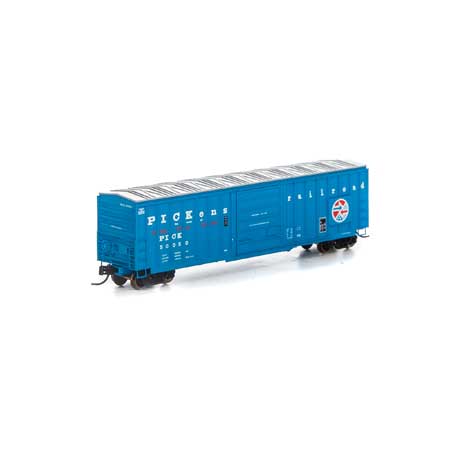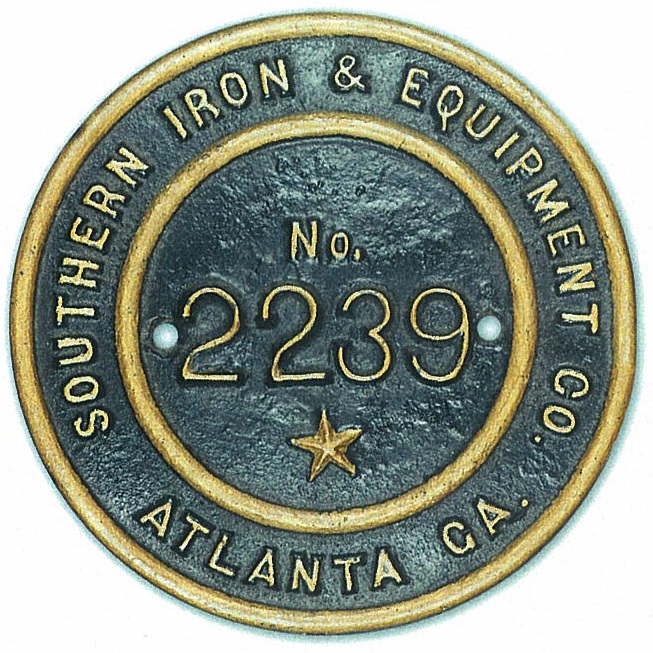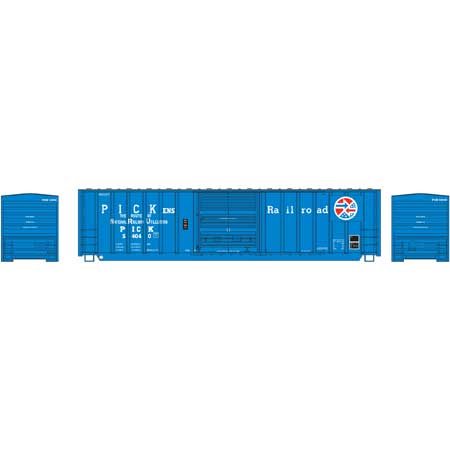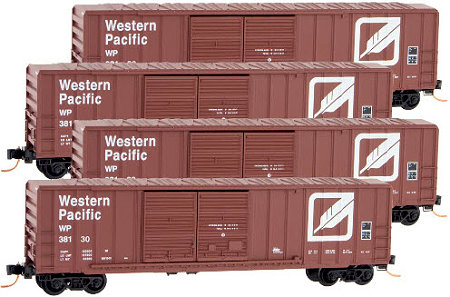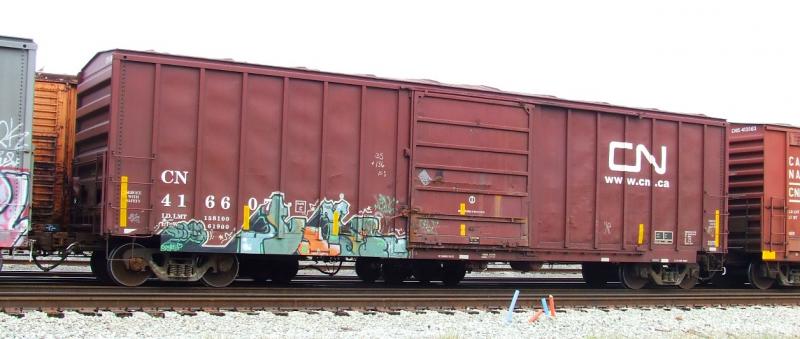Model Information: MODEL FEATURES:
Fully detailed molded under frames,
Screw mounted trucks for enhanced performance,
Accumate magnetically operated knuckle couplers,
Weighted for optimum operation,
Photo etched stirrup steps provide scale cross section,
Scale profile brake wheels.
Prototype History: The 1970s saw a shift in general purpose boxcars from 40 foot to 50 foot exterior post designs. The incentive per diem regulations (IPD) made it very attractive for railroads to acquire large fleets of boxcars. Along with the larger companies like Pullman Standard and American Car & Foundry (ACF), Southern Iron & Equipment Co. (SIECO) also jumped into the 50 foot boxcar business. The SIECO railcars were recognizable by the "gap" between the roof and walls of the car.
Road Name History: The Easley-Pickens line was chartered on December 24, 1890, by the South Carolina General Assembly after two failed attempts to build a railroad through Pickens from Easley. The line connected with the Atlanta and Charlotte Air Line Railroad (later the Southern Railway) and was completed in 1898.
On the railroad's first revenue run, the Pickens Railroad suffered a serious derailment that was caused by a local group of boys that had placed spikes on the rails, in their words, "to see what would happen." No one was seriously injured, but caused the fledgling company a serious financial setback, which operated in the red until 1905.
In its early years, it was nicknamed the "Pickens Doodle" because the train would run backwards to Easley and forward to Pickens, which "looked like a doodlebug," according to area residents. The Pickens Railroad, at the time did not have turning facilities until the line built two wye sections of track at each end of the line years later.
The Southern Railway briefly acquired control of the Pickens around 1910, however, it was reverted to local interests several years later.
In the 1920s, Singer Manufacturing located a sewing machine cabinet plant on the Pickens Railroad. The plant eventually became the railroad's biggest customer and the line was purchased outright in 1939 by Singer. In 1927, the Appalachian Lumber Company built a network of logging lines in the upper portion of Pickens County. By 1939, it too was also acquired by Singer and organized under the Poinsett Lumber and Manufacturing Company. Passenger service was discontinued in 1928 as better roads were built in the region.
In 1959, The Singer Company consolidated its sawmill and cabinet operations with the woodworking operations from Arkansas and the Craftsman power tools from New Jersey to the Pickens location. In 1963, Poinsett Lumber and Manufacturing Company announced that the Pickens Railroad was for sale. James F. Jones of North Carolina purchased the line for approximately $50,000.[1] Jones built a new enginehouse and established a carshop for rebuilding and renovating railroad cars. Jones sold the Pickens in 1973 to Philadelphia-based National Railway Utilization Company (NRUC), which expanded the carshop to build new freight cars.
In the early 1990s NRUC became Emergent Group and sold the railroad to CLC-Chattahoochee Locomotive Corp., which renamed the railroad Pickens Railway Company, according to the Federal Register, 1 May 1996. On April 2, 2013, Pickens Railway pulled the last train to Easley because of lack of business. The final run was pulled by Pickens #9502 and CLCX #12132. The last train ended an era of over 100 years of running to Easley.
On the railroad's first revenue run, the Pickens Railroad suffered a serious derailment that was caused by a local group of boys that had placed spikes on the rails, in their words, "to see what would happen." No one was seriously injured, but caused the fledgling company a serious financial setback, which operated in the red until 1905.
In its early years, it was nicknamed the "Pickens Doodle" because the train would run backwards to Easley and forward to Pickens, which "looked like a doodlebug," according to area residents. The Pickens Railroad, at the time did not have turning facilities until the line built two wye sections of track at each end of the line years later.
The Southern Railway briefly acquired control of the Pickens around 1910, however, it was reverted to local interests several years later.
In the 1920s, Singer Manufacturing located a sewing machine cabinet plant on the Pickens Railroad. The plant eventually became the railroad's biggest customer and the line was purchased outright in 1939 by Singer. In 1927, the Appalachian Lumber Company built a network of logging lines in the upper portion of Pickens County. By 1939, it too was also acquired by Singer and organized under the Poinsett Lumber and Manufacturing Company. Passenger service was discontinued in 1928 as better roads were built in the region.
In 1959, The Singer Company consolidated its sawmill and cabinet operations with the woodworking operations from Arkansas and the Craftsman power tools from New Jersey to the Pickens location. In 1963, Poinsett Lumber and Manufacturing Company announced that the Pickens Railroad was for sale. James F. Jones of North Carolina purchased the line for approximately $50,000.[1] Jones built a new enginehouse and established a carshop for rebuilding and renovating railroad cars. Jones sold the Pickens in 1973 to Philadelphia-based National Railway Utilization Company (NRUC), which expanded the carshop to build new freight cars.
In the early 1990s NRUC became Emergent Group and sold the railroad to CLC-Chattahoochee Locomotive Corp., which renamed the railroad Pickens Railway Company, according to the Federal Register, 1 May 1996. On April 2, 2013, Pickens Railway pulled the last train to Easley because of lack of business. The final run was pulled by Pickens #9502 and CLCX #12132. The last train ended an era of over 100 years of running to Easley.
Brand/Importer Information: Athearn's history began in 1938, when its founder-to-be, Irvin Athearn, started an elaborate O scale layout in his mother's house. After placing an ad selling the layout, and receiving much response to it, Irv decided that selling model railroads would be a good living. He sold train products out of his mother's house through most of the 1940s. After becoming a full-time retailer in 1946, Irv opened a separate facility in Hawthorne, California in 1948, and that same year he branched into HO scale models for the first time.
Athearn acquired the Globe Models product line and improved upon it, introducing a comprehensive array of locomotive, passenger and freight car models. Improvements included all-wheel drive and electrical contact. One innovation was the "Hi-Fi" drive mechanism, employing small rubber bands to transfer motion from the motor spindle to the axles. Another was the double-ended ring magnet motor, which permitted easy connection to all-wheel-drive assemblies. Athearn was also able to incorporate flywheels into double-ended drives.
The company produced a model of the Boston & Maine P4 class Pacific steam locomotive which incorporated a cast zinc alloy base and thermoplastic resin superstructure. It had a worm drive and all power pickup was through the bipolar trucks that carried the tender. This item was discontinued after the Wilson motor was no longer available, and was not redesigned for a more technologically advanced motor.
Athearn's car fleet included shorter-than-scale interpretations of passenger cars of Southern Pacific and Atchison, Topeka & Santa Fe Railroad prototypes. The company also offered a variety of scale-length freight cars with sprung and equalized trucks. The cars could be obtained in simple kit form, or ready-to-run in windowed display boxes. The comprehensive scope of the product line contributed to the popularity of HO as a model railroad scale, due to the ready availability of items and their low cost.
Irv Athearn died in 1991. New owners took control in 1994, but continued to follow Athearn's commitment to high-quality products at reasonable prices. Athearn was bought in 2004 by Horizon Hobby. Athearn was then moved from its facility in Compton to a new facility in Carson, California. In mid-2009, all remaining US production was moved to China and warehousing moved to parent Horizon Hobby. Sales and product development was relocated to a smaller facility in Long Beach, California.
Read more on Wikipedia and Athearn website.
Athearn acquired the Globe Models product line and improved upon it, introducing a comprehensive array of locomotive, passenger and freight car models. Improvements included all-wheel drive and electrical contact. One innovation was the "Hi-Fi" drive mechanism, employing small rubber bands to transfer motion from the motor spindle to the axles. Another was the double-ended ring magnet motor, which permitted easy connection to all-wheel-drive assemblies. Athearn was also able to incorporate flywheels into double-ended drives.
The company produced a model of the Boston & Maine P4 class Pacific steam locomotive which incorporated a cast zinc alloy base and thermoplastic resin superstructure. It had a worm drive and all power pickup was through the bipolar trucks that carried the tender. This item was discontinued after the Wilson motor was no longer available, and was not redesigned for a more technologically advanced motor.
Athearn's car fleet included shorter-than-scale interpretations of passenger cars of Southern Pacific and Atchison, Topeka & Santa Fe Railroad prototypes. The company also offered a variety of scale-length freight cars with sprung and equalized trucks. The cars could be obtained in simple kit form, or ready-to-run in windowed display boxes. The comprehensive scope of the product line contributed to the popularity of HO as a model railroad scale, due to the ready availability of items and their low cost.
Irv Athearn died in 1991. New owners took control in 1994, but continued to follow Athearn's commitment to high-quality products at reasonable prices. Athearn was bought in 2004 by Horizon Hobby. Athearn was then moved from its facility in Compton to a new facility in Carson, California. In mid-2009, all remaining US production was moved to China and warehousing moved to parent Horizon Hobby. Sales and product development was relocated to a smaller facility in Long Beach, California.
Read more on Wikipedia and Athearn website.
Item created by: gdm on 2018-06-28 12:21:25
If you see errors or missing data in this entry, please feel free to log in and edit it. Anyone with a Gmail account can log in instantly.
If you see errors or missing data in this entry, please feel free to log in and edit it. Anyone with a Gmail account can log in instantly.


